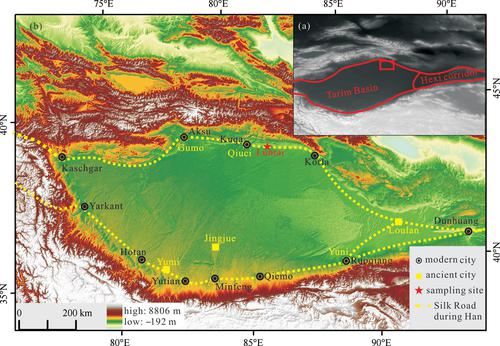当前位置:
X-MOL 学术
›
Acta Geol. Sinica Engl. Ed.
›
论文详情
Our official English website, www.x-mol.net, welcomes your
feedback! (Note: you will need to create a separate account there.)
Hydrological Variations and the Ancient Silk Road in the Northern Tarim Basin between Han and Sui Dynasties
Acta Geologica Sinica-English Edition ( IF 3.5 ) Pub Date : 2020-06-26 , DOI: 10.1111/1755-6724.14540 Fenglin LÜ 1, 2 , Hua ZHANG 1 , Juzhi HOU 2, 3 , Xianyong CAO 2, 3 , Chenglin LIU 1
Acta Geologica Sinica-English Edition ( IF 3.5 ) Pub Date : 2020-06-26 , DOI: 10.1111/1755-6724.14540 Fenglin LÜ 1, 2 , Hua ZHANG 1 , Juzhi HOU 2, 3 , Xianyong CAO 2, 3 , Chenglin LIU 1
Affiliation

|
The fluctuation pattern of China's civilization can be ascribed to climate change and historical geopolitical variations. The ancient Silk Road served as the most prosperous route connecting East Asia and Europe during Han Dynasty (206 BC–220 AD) and Sui‐Tang Dynasties (581–907 AD), but was deserted in Wei, Jin, Northern and Southern dynasties (220–580 AD), of which the Tarim Basin was a key area. However, our understanding about the decline of the route during this period remains limited. Here, we present an ~7‐year resolution record based on optically stimulated luminescence (OSL) age‐depth model (ca. 120 BC–750AD) from Luntai (LT) profile, about 5 km from the modern Tarim River, which fed the ancient oases, to assess the potential causes on the documented decline of the ancient Silk Road between Late Han and Sui dynasties. In this study, five episodes of hydrological change were identified by combining grain size, magnetic susceptibility, geochemistry and TOC/TN contents. Our reconstruction reveals that cold and wet climate dominated at 120BC–50 AD and 550–750AD, respectively, indicated by strong hydrodynamic conditions. Relatively warm and humid climate occurred at 120–550AD, between Eastern Han and Sui‐Tang dynasties, indicating a better and more suitable local environment. A comparison between the studied region and other areas of China demonstrates that the paleoclimatic variations in eastern and western China exhibit rough discrepancies, and the hydrological conditions in arid region is inconsistent with the decline of ancient Silk Road in the northern Tarim Basin. We suggest that political and societal factors are the key issues that caused the interruption of Silk Road during Wei, Jin, Northern and Southern dynasties, such as the co‐occurrence of societal crises, turmoil and division in eastern China, rather than the deteriorating climatic condition in the northern Tarim basin.
更新日期:2020-06-26











































 京公网安备 11010802027423号
京公网安备 11010802027423号